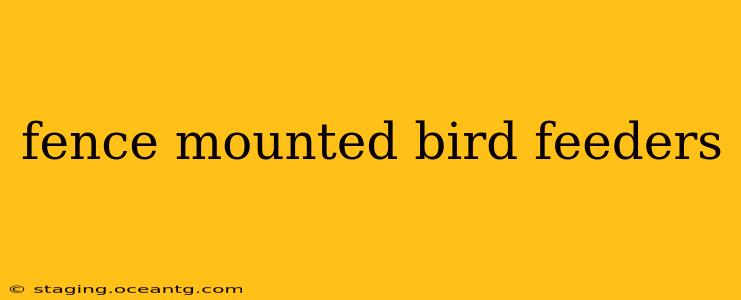Attract feathered friends to your garden with a fence-mounted bird feeder! This convenient and space-saving solution offers a unique way to enjoy birdwatching without sacrificing valuable yard space. This guide explores the various types, installation methods, and considerations for choosing the perfect fence-mounted bird feeder for your backyard.
What are the Benefits of Fence-Mounted Bird Feeders?
Fence-mounted bird feeders provide several advantages over traditional stand-alone feeders:
- Space Saving: Ideal for smaller yards or gardens where space is limited.
- Easy Access: Convenient for filling and cleaning, especially those mounted at a comfortable height.
- Predator Protection: Certain designs offer increased protection from squirrels and cats by utilizing cages or strategically placed perches.
- Aesthetic Appeal: They can add a charming and functional element to your fence line.
- Variety of Styles: Available in various materials, designs, and capacities to suit any aesthetic and bird species.
What Types of Fence Mounted Bird Feeders are Available?
Several types cater to different preferences and bird species:
- Tube Feeders: These offer easy access to seeds and are popular with various birds. They often come with protective cages to deter squirrels.
- Platform Feeders: Provide a flat surface for larger birds and those that prefer to feed on the ground. Consider a design with a cage or barrier to protect the feed from larger animals.
- Suet Feeders: Ideal for providing high-energy food during cold weather. Fence-mounted suet feeders are often enclosed to protect the suet from the elements and animals.
- Combination Feeders: These offer multiple feeding areas for various bird species and food types.
How to Install a Fence Mounted Bird Feeder?
Installation is generally straightforward:
- Choose a location: Select a spot away from heavy foot traffic and direct sunlight to prevent the food from spoiling quickly. Consider the height for ease of access and bird preference.
- Select mounting hardware: Use appropriate screws or hooks designed for your fence material (wood, vinyl, metal). Ensure they are strong enough to support the weight of the feeder and its contents.
- Attach the feeder: Securely fasten the feeder to the fence using the provided hardware or appropriate alternatives. Ensure it is stable and won't easily detach.
- Fill with food: Choose birdseed appropriate for your local species.
- Regularly clean and maintain: Regularly clean and disinfect the feeder to prevent disease.
What is the best type of fence for mounting a bird feeder?
The best fence for mounting a bird feeder depends on the material and its construction. Wood fences are generally easier to work with, as screws are easily inserted. Vinyl and metal fences might require specialized mounting hardware or techniques. Check your fence for structural integrity before installation to ensure it can support the weight of the feeder and the birds. Always check the weight capacity of the feeder itself.
How high should I mount my fence bird feeder?
The ideal height depends on your specific situation and the types of birds you wish to attract. However, a height between 4 and 6 feet is often recommended for a good balance between accessibility for filling and safety from ground predators. Consider your personal comfort for filling and cleaning the feeder.
How do I prevent squirrels from getting into my fence-mounted bird feeder?
Squirrels are notorious for raiding bird feeders. To prevent this:
- Choose squirrel-resistant feeders: Look for feeders with cages or baffles that deter squirrels from accessing the food.
- Use slippery perches: Squirrels struggle to climb surfaces with smooth textures.
- Strategic placement: Mount the feeder in a location that is difficult for squirrels to reach. Place the feeder away from trees or other climbing aids.
What kind of birdseed is best for a fence-mounted feeder?
The best type of birdseed depends on the species of birds you want to attract. A mix of seeds like sunflower seeds, niger seeds, and cracked corn is popular. Research local bird species and their preferred foods to create the most appealing mix for your location. Avoid stale or moldy seeds.
By following these tips, you can successfully install and maintain a fence-mounted bird feeder, providing a safe and enjoyable feeding area for your local avian visitors while adding a touch of beauty to your yard. Remember to always prioritize the birds’ safety and well-being.
